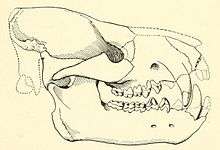Helohyidae
Helohyidae (eloids) are a group of extinct artiodactyl mammals.[1][2] They lived mainly in the mid-to-upper Eocene (about 50 to 39 million years ago), although some fossils were found in land in the upper Oligocene (about 28 million years ago).[3]
| Helohyidae | |
|---|---|
 | |
| Reconstruction of the skull of Achaenodon | |
| Scientific classification | |
| Kingdom: | Animalia |
| Phylum: | Chordata |
| Class: | Mammalia |
| Order: | Artiodactyla |
| Family: | †Helohyidae |
Description
These animals had to look vaguely like small, slim-bodied pigs. They possessed prominent canines and molars with bunodont cuss; the dental wreaths were bulging and the enamel was wrinkled. The upper molars were usually squared, due to the enlargement and displacement of the metaconule, but there was also a small hypoconno, but there was also a small hypoconsque; the paracholo was reduced and there was no mesostil. The lower molars increased the size as they proceeded to the bottom of the jaw, and the paraconid was small or absent. Some forms (e.g. Gobiohyus) possessed small diathemes that separated the premolars from each other. The snout was usually elongated (e.g. in Helohyus), but in some forms ascribed to this family (Achaenodon) it was very short. Compared to other primitive artiodactyls such as dichobunids, the eloids possessed higher sagittali ridges; the genus Achaenodon, in particular, possessed a large sagittal crest and its size was much larger than those of other eloiids.
Classification
The Helohyidae family was established by Marshall in 1877, to accommodate some forms of early artiodactyl mammals of the American Eocene. In addition to the genus Helohyus, the North Americans Dyscritochoerus, Parahyus and Achaenodon were later ascribed to this family. Other forms come from the Upper-Middle-East Eocene of Asia (Gobiohyus[4] of Inner Mongolia, Pakkokuhyus of Burma and Progenitohyus[5] of Thailand. The latter form may be close to the origin of the family of hippos-like anthrax. The last known eloiid is Simojovelhyus of The Upper Oligocene of Mexico: the discovery of this form implies the existence of a ghost lineage of eloids of about 10 million years (Ferrusquea-Villafranca, 2006).
Eloiids have been variously classified as relatives of archaic dichobunids or as close to the origin of anthrachotheds. The current opinion is to classify them as relatives of the dichobunids (McKenna and Bell, 1997; Stucky, 1998; Rose, 2006).
References
- Ducrocq, Stéphane; Chaimanee, Yaowalak; Suteethorn, Varavudh; Jaeger, Jean-Jacques (September 1, 1997). "First discovery of Helohyidae (Artiodactyla, Mammalia) in the Late Eocene of Thailand: a possible transitional form for Anthracotheriidae". Comptes Rendus de l'Académie des Sciences - Series IIA - Earth and Planetary Science. 325 (5): 367–372. doi:10.1016/S1251-8050(97)81385-7 – via ScienceDirect.
- "Fossilworks: Helohyidae". fossilworks.org.
- "Helohyidae". www.gbif.org.
- Coombs, Margery C.; Coombs, Walter P. (20 August 1977). "Dentition of Gobiohyus and a Reevaluation of the Helohyidae (Artiodactyla)". Journal of Mammalogy. 58 (3): 291–308. doi:10.2307/1379328. ISSN 0022-2372.
- Ducrocq, Stéphane; Chaimanee, Yaowalak; Suteethorn, Varavudh; Jaeger, Jean-Jacques (September 13, 1997). "First discovery of Helohyidae (Artiodactyla, Mammalia) in the Late Eocene of Thailand: a possible transitional form for Anthracotheriidae". CRASE. 325 (5): 367–372. doi:10.1016/S1251-8050(97)81385-7 – via ui.adsabs.harvard.edu.